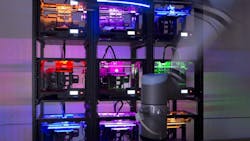Two of the most trending automation technologies—3D printing and collaborative robots (cobots)—have been brought together in Voodoo Manufacturing’s Brooklyn, N.Y., production operations. Currently using 160 3D printers, Voodoo Manufacturing—a startup manufacturing business—produces products ranging from prosthetic hands to protective dog eyewear.
Voodoo Manufacturing began looking into the use of a robot to automate the process of loading materials into its printers and unloading the finished products. “When we began looking for a robotic arm, we were looking for one that could do the tasks, but would also be easily programmable to get up and running very quickly,” said Jonathan Schwartz, chief product officer of Voodoo Manufacturing.
He added that, in developing the company’s “Project Skywalker” setup—which Voodoo Manufacturing believes to be the first-ever robot operated cluster of 3D printers—“We didn’t have a couple of years to put something through R&D, we needed it here and now.” The speedy pace of the project was driven by Voodoo Manufacturing’s ongoing pitches to investors as a startup company.
The company selected the UR10 robot arm from Universal Robots (UR), whose robots are classified as “collaborative” due to their built-in safety system that makes the robot arm automatically stop operating if it encounters objects or people within its path of movement. Voodoo Manufacturing estimates that the cost of implementing a UR robot was about five times less expensive than a traditional industrial robot due to the quick integration that did not involve safety cages, light curtains and other safety measures usually needed when robots work in a factory setting.
Schwartz noted that, in addition to the lower cost of the collaborative robot technology, the speed with which it could be set up was also a determining factor in its selection. “We got the UR10 out of the box and were able to get it running within just a few hours,” he said.
The UR10’s loading and unloading of plates into and out of the 3D printers is called “harvesting,” a process which consumed 10 percent of human labor hours before the introduction of the robots. Schwartz described this low-value-added activity as “a perfect and almost quantifiable task” that he felt confident could be automated with speed, accuracy and precision.
By placing the UR10 on a mobile base capable of roaming the company’s 18,000-square-foot factory, the collaborative robot can tend 100 of Voodoo Manufacturing’s printers. Based on its initial success with the first UR10 robot—which enabled the company to triple its production output—Voodoo Manufacturing plans to add another UR10 to its fleet. Schwartz estimates that doing so will take Voodoo Manufacturing from 30-40 percent printer utilization up to 90 percent. “And … as we scale, we can just buy more arms as we add more and more printers,” he said.
The key to Voodoo Manufacturing’s ability to triple its output with the UR10 is the fact that the robot can run overnight. “We can monitor the robot through our own software and access the status of any given printer to see whether it’s printing or idle, which means we can deploy this in our factory and run it 24/7 without any human oversight,” said Schwartz.
A critical factor of the robot technology used in Voodoo Manufacturing’s harvesting application is the robot’s gripper. “One important aspect for choosing the UR10 was that there were really good peripherals that we could use with it,” said Schwartz, who chose a two-fingered gripper from Robotiq. The gripper is part of Universal Robots+ platform that features plug-and-play products for UR robots. To be part of the UR+ platform, products are tested and proven to work seamlessly with UR hardware and software. In the case of the Robotiq gripper, the gripper’s software has been integrated on the UR robots’ touch screen, thereby eliminating hours of code scripting by a system integrator or end user.
Charlie Fenwick, industrial engineer at Voodoo Manufacturing, emphasized how the UR+ integration ended up being the deciding factor in choosing the UR robot. “We looked at different robot arms, but none of them had the ability to easily interface with the peripherals required to get the complete application up and running,” he said. “Getting the gripper to work with the arm was almost like building a Power Point slide—just dragging blocks of information onto the screen. All you have to do is link up the different blocks and it basically runs itself,” said Fenwick.
Voodoo Manufacturing’s three-year goal is to reduce costs by 90 percent. The increased output, coupled with the reduction in labor cost provided by the company’s first UR10, means that the robot will pay for itself in less than six months.
“If we’re going to increase our output ten-fold over the next couple of years, we have to do that without increasing our costs by 10x and the robots will be instrumental in achieving this,” said Schwartz. “Beyond this [first step] there are many other opportunities in our factory to automate; whether it is removing parts from the build plates, cleaning them, inspecting them for quality, or eventually even packing and shipping.”

